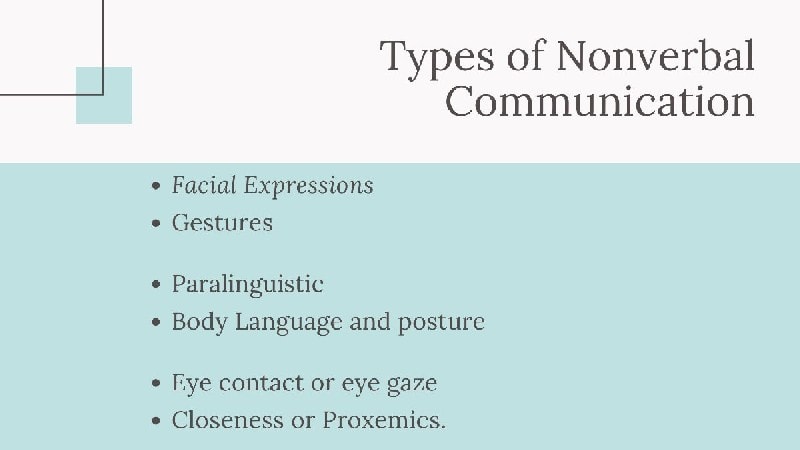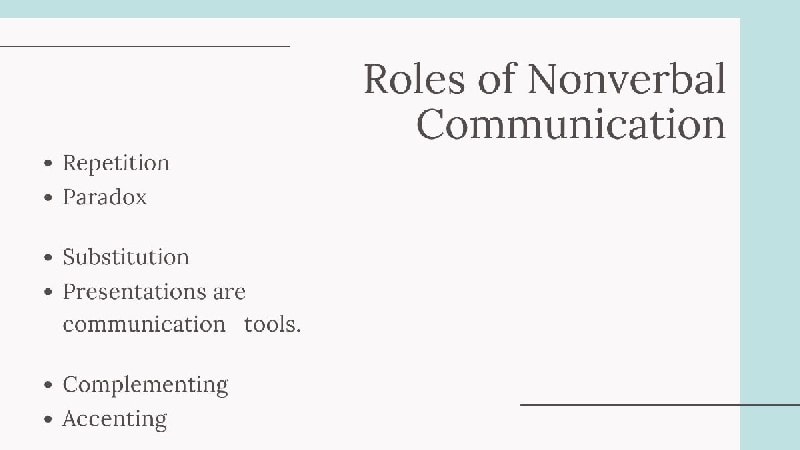The form of communication that occurs without using words is understood as Non-Verbal Communication.
Facial expressions, gestures, postures, tone and pitch of the voice, kinesics, proxemics, etc. play a key role in non-verbal communication.
As per the stats, more than 70 to 80% of the communication is nonverbal.
In businesses, nonverbal communication plays a crucial role in revealing who we are, plus it also impacts our interpersonal relationships as well as business relations.
Have you considered the latest insights on non-verbal communication?
According to recent industry insights from Forbes, non-verbal communication is increasingly leveraged in virtual environments as more businesses adopt hybrid work models. With approximately 30% of communication in remote work settings relying on visual cues, understanding and improving non-verbal communication in virtual meetings has become crucial. Tools such as Zoom and Microsoft Teams have incorporated features like virtual backgrounds and enhanced video quality to support clearer non-verbal exchanges (Forbes, 2023).
In terms of practical advice, it’s recommended to enhance your virtual non-verbal communication by ensuring you are well-lit during video calls to better convey facial expressions. Additionally, maintaining eye contact by looking directly into the camera, rather than at your screen, can create a more engaging and trustworthy impression. Using gestures and maintaining an upright posture can also help in making your communication more effective and assertive in online settings (Harvard Business Review, 2023).
In this post, we will be covering the nitty-gritty of nonverbal communication and will try to understand how important it is in adept channelisation of a business. We will also delve into different types of nonverbal communication and their role in appreciating more favourable decisions.
So, without any further ado, let us start unfolding the critical concepts of nonverbal communication-
Table of Contents
Introduction to Nonverbal Communication
Nonverbal communication often called the dialect of the heart is the method of transmitting messages without using words.
Nonverbal communications have been regarded as a critical aspect of disclosure for the ages. It applies to gestures, facial expressions, tone of voice, a touch of the eye, the language of the body, stance and other ways of communication through which one puts different messages forwards without using the medium of spoken language.
Such non-verbal signs can provide hints and context of spoken communication.
Yes, some estimates suggest that the most substantial portion of human conversations occur in the non-verbal fashion.
Interpersonal physical contact is much more than the explicit meaning of words and the message they convey. It also contains implicit messages that are expressed by non-verbal actions, whether intentional or not.
In many situations, we use behaviour classes to communicate information for nonverbal communication types and ways. For example, to suggest disapproval, we might combine a frown with crossed arms and unblinking eye gaze.
In the interviews or other sessions, HR managers analyse one’s personality through your nonverbal communication such as your way of talking tells how confident you are, plus, your gestures and postures play a significant role in the process.
In business dealings, incorporating the right nonverbal styles is also essential in ensuring favourable outcomes.
So, you can make the best impression by using your nonverbal communication skills.
It may seem unprofessional to have poor postures. Seeing downward or not maintaining eye contact gives the signal that you are either not confident or not entirely interested in the conversations.
You must incorporate the right forms of nonverbal communication skills so that you can have the right impressions on your audiences. This will also increase the importance of your verbal communication.
Uses of Non-verbal Communication
1) Reinforcement or modification of spoken words
You can nod your head when you give your consent for something to underline that you are in full agreement with the other individual. A wave with a sad look may mean that things aren’t excellent!
2) Expressing emotions
Your facial expression, vocal tone, and posture can often tell people exactly how you feel, even if you haven’t spoken a word.
Example:
“Are you fine? You look a little unwell.”
No one tells you that they are unwell, but from their non-verbal communication; you will get to know how people feel.
3) Defining relationships
You may have noticed that the body language of sisters, they tend to have a relationship without expressing it through verbal means, which is visible through their nonverbal communication.
The comfort or the discomfort, or way of communicating with each other, etc. are the traits that tell others about the relationship between two individuals.
4) Giving Feedbacks about different things
Smiles and expressions tell you that you’re listening and that you’re in agreement with what they’re doing. Movements and hand gestures can mean that you want to talk.
Your instant expression can tell people about your likings or disliking, and those who are supposed to make decisions as per the inclinations of their audiences always notice such gestures and postures.
5) Regulation of communication flow
We use a variety of signs to tell people that we’ve finished speaking or that we want to talk. For example, an emphatic nod and a firm lip closure suggest that we have nothing more to say.
Contacting the chair of a meeting with your eye and slightly nodding will indicate you want to talk.
Types of Nonverbal communication
1) Facial Expressions
They are responsible for an enormous proportion of nonverbal communication.
Consider how much information a smile or a frown can convey.
Although nonverbal communication and actions can vary dramatically across cultures, the facial expressions of joy, sorrow, frustration, and fear all over the world are identical.
While making any conversation with anybody, we always notice their facial expressions to gauge one’s inner feelings.
2) Gestures
Purposeful body movements and indicators are an essential means of communicating meaning without using the verbal means of communication.
Common gestures include waving, pointing, and indicating numerical amounts using fingers. Some many other actions and gestures are arbitrary and they vary with different cultures.
Business communications, government offices, schools, meeting rooms, and professional gatherings, practise different types of gestures that play a significant role as the nonverbal communication medium.
3) Paralinguistic
Paralinguistic applies to vocalisation that is distinct from the language itself.
This covers aspects such as your voice tone while talking to someone, the intonation, modulation or pitch of your voice tell some critical details about what is going on your head while speaking anything.
So, just paying attention and heed to the powerful impact on the interpretation of a sentence that the tone of voice can have is one crucial aspect of nonverbal communication.
Loud voice tone might interpret enthusiasm or dissent.
Similar words said in a hesitant voice might not convey confidence or a lack of interest or disapproval.
So, it is all about the nonverbal representation of a language that plays the role of the deciding factors.
4) Body Language and posture
Body language can be seen as hand gestures or nodding or shaking of the head or the way you are sitting, how your hands are positions. Etc.
It is often the most accessible item to regulate in non-verbal communication.
Posture is the defined position in which we stand, walk or sit.
5) Eye contact or eye gaze
The degree of confidence in one’s speech, discussion or interview session is often measured by the kind of eye contact they have.
The eyes play a significant role in nonverbal communication, and effective nonverbal habits include things like gazing, concentrating and blinking.
The rate of blinking increases when people encounter people or things they like and pupils dilate. Looking at someone else may signify a variety of emotions like aggression, desire, and attraction.
We also use eye contact as a means of determining whether someone is honest.
Regular, constant eye contact is often taken as a sign that a person tells the truth and is trustworthy. But on the other side, duplicitous eyes and an inability to maintain eye contact are often seen as a sign of deception or being manipulative.
6) Closeness or Proxemics
This determines the closeness and intimacy and may differ from culture to culture, person to person and profession to profession.
It can also be referred to as personal space.
The kind of closeness, compassion or intimacy that you show towards others plays a crucial role in nonverbal communication.
For instance, when you have a casual conversation with someone, it is suggested that you can have a distance between 1.5 feet to 4 feet. While at the time when you speak to a crowd, it is advised to have a personal range of 10 to 15 feet.
7) Physiological Changes
When you’re anxious, you can sweat or twitch more, and your heart rate may also rise.
These are almost difficult to monitor and are thus a potent mental state predictor actively.
Different such sorts of signals act as the nonverbal means of communication, and it tells about the kind of discomfort one is going through in the process.
8) Artefacts
The use of different types of images or objects also plays vital roles as a powerful means of nonverbal communication.
They play a crucial role in your personality, brand tone, and other vital signals.
When you go to an office, the décor of the interiors or exteriors play a crucial role in impacting people’s subconscious and telling them about the kind of person you are.
Kind of images used on a website or one’s online profile tells a lot about one’s personality.
9) Appearance
How you appear yourself at any event, interview or occasion also plays a crucial role in nonverbal communication.
So, your clothing, choices of colours, hairstyles, etc. are some of the factors you need to pay heed to for making your presence more impactful.
Importance of Nonverbal Communication
The importance of non-verbal communications is that it is not generally faked and in most cases is instinctive and is used to show emotions like anger, happiness, sadness, pleasure, anxiety, annoyance, hurt, curiosity, interest, and hope. Sometimes it is not easy to interpret non-verbal signals because it does not have any fixed meaning and might differ from individual to individual.
Non-verbal communication has been described as an effectual communication process because the message is delivered and communicated more accurately than verbal communication. It is a fact that when a person speaks it is not just with words as his whole body is involved somehow or the other. Suppose you meet a friend then the smile on your face is more radiant but if you see someone you are not comfortable with then your fidgety behavior will show your unease.
The non-verbal communication is not always intended and in most cases is an automatic or instinctive reaction because people are also less conscious about it than the verbal one. The importance of non-verbal communication is that it gives credence to the verbal one if both are synchronized at the time of speaking.
1. Helps in Better Understanding and Communication
Non-verbal mode of communication can exist with or without verbal communication and has a significant role in making a good impact. This interpersonal communication makes a strong and long-lasting impression that either compliments or can also contradict verbal communication with a glance or gesture.
The importance of non-verbal communication is that it begets a better understanding of individuals or even groups. Sometimes a person shows great self-confidence while talking verbally and it becomes impossible to determine any adverse nuances from his words. It is at this time that non-verbal communication proves a stroke of luck and helps the listener to come to a better understanding.
The posture of the speaker might be confident but he will leave certain signals showing his true intention, for instance, is there an eye contact and is his facial expression too calm and collected.
Is the non-verbal signals matching his verbal tone is an important question that the listener should pay close attention to if he is looking for the truth of the statements.
2. Helps in different processes in Business
It is a fact that non-verbal communication is mostly contextual in nature but without its help, verbal communication remains incomplete. In few cases, it is in itself a complete statement and you do not need words to put your thoughts across but mostly it is a companion of verbal communication so as to emphasize the importance of the situation. The business has numerous demands of its own and it is important for the owner or the management to have an upper hand in business dealings that can prove a blessing for them.
The importance of non-verbal communication is that it helps in numerous aspects of business for instance in the hiring process. During interviews, the human resource department can easily make assumptions during a face-to-face meet and determine which applicants they want to see in the next round.
Similarly, it is easier for the experienced managers or management team to decipher the expressions of other employees, for instance, are they maintaining eye contact or are squirming in their chair or is the employee showing an interest in the conversation or is he looking at his watch on a continuous basis? Non-verbal communication is a great indicator that depicts the truth about the intention and trustworthiness of an individual’s character.
3. Helps to emphasize your main points
Non-verbal communication is actually a silent form of sending a message to someone without using words or any form of speech. It is influential by nature and is often successful in grabbing the attention of its audience. When the non-verbal signal is contradictory to verbal communication remember it is the time to be cautious and to pay close attention to what is being said. It is a fact that even silence has a deeper meaning of its own.
A person can understand better if verbal communication is accompanied by non-verbal signals for instance when a person says he is having a headache it is natural for his hand to touch his forehead to indicate the extreme pain. Similarly, if a person is interested in pointing out to a certain part of a message he can deepen his tone and put a serious facial expression during that time to accentuate his point.
The importance of non-verbal communication during important conversations is that it can help to emphasize certain points that are vital to that conversation. Some signs like anger, smile or aggression can help a person in making a particular point easily.
4. It is important in the workplace
Depending upon the profession an individual has to spend a greater part of his day in his workplace. He has to take immense care of his non-verbal communication so that his actions or gestures are not taken otherwise. In order to maintain a cordial workplace relationship, a person needs to show his enthusiasm for the job through an exciting look instead of a monotonous facial expression.
Remember it is the non-verbal signal that actually gives out the accurate vibes about your feelings to others hence put a smile on your face while entering the workplace, nod when listening to others and maintain eye contact to show that you are interested in whatever is spoken to you.
The importance of non-verbal communication is that it is a great help in manage stress and maintaining workplace efficiency.
5. It is important for babies and children
A child relies on non-verbal communication since the time of his birth. He does not know the language or has any verbal means to speak the words and tell about his wants and needs to his parents or people close to him. It is the non-verbal communication that is a godsend at this point in time. A child cries frequently to make his mother or caretaker signify that something is wrong.
He might have been bedwetting and the cry is for someone to change his diaper. When the child is hungry he cries until his hunger is satisfied. After some months he starts recognizing faces and smiles after seeing some of the familiar ones.
The cooing sounds that parents make while interacting with a small child do not have any meaning but signify a rapport and non-verbal communication to the baby. It is a fact that words are not needed to express emotions to children because a warm hug, a smile or a warm greeting are enough to make them feel secure. Even before we utter a word the baby or the child observes the person’s body language and gestures and can interpret the meaning through facial expression.
A baby or a child trusts the non-verbal communication and believes then to be true and as the gestures and expression are mostly unconscious people tend to rely on them more than the words which can be meaningless.
6. Non-verbal communication reinforces the words
The symbolic messages attached to words are observed and interpreted by people even before they hear the actual words. For instance when a person is asking you something and you want to reply yes or no you will always nod your head to signify an affirmative or negative answer.
Suppose you see a friend and he looks tired to you. When you ask him how he is feeling he might reply ok but his sad and tired expression might indicate that he is not as fine as he is saying. The importance of non-verbal communication is that it gives credence to the words so that the listener can actually believe about the things that are said to him.
The tone of voice, expression, gestures like a sigh or a shrug and emotions like smile, warmth or angry face are all indicators of your true feelings. When movements are accompanied by words it helps the listener to identify the actual meaning because the action is reinforcing the validity of the statement.
Non-verbal communication can have a significant impact on the audience and interaction performance.
Nonverbal words depend upon the way one listens, looks, moves, and talks.
When the words you say suit your nonverbal signals, they improve confidence, understanding, and relationship. On the other hand, they can create tension, mistrust, and confusion if they don’t.
During interviews and networking sessions, most candidates carefully plan what they are going to say and how they are going to appear.
Knowing what you’re going to say is just part of the picture that you are going to create with your appearance.
It’s just as important to understand how thoughts can be conveyed through your body language. Your success in interviewing and networking will depend mainly on the impression people get from you and how they react to what you say.
Here is a video by Marketing91 on Nonverbal Communication.
Role of Nonverbal Communication
Following is the role of nonverbal, verbal cues, and nonverbal behaviors in the interpersonal communication.
-
Repetition: It focuses on repeating and often confirming the message that you are verbally making.
-
Paradox: It might contradict the message that is being conveyed, thus making a doubt in the mind of the listener of whether one is speaking the truth or not. So it can work as a paradox as well.
-
Substitution: It can replace a verbal post. Your facial expression, for example, frequently conveys a meaning far more vivid than words can ever have.
-
Complementing: It can add to your verbal message or compliment this. As a manager, it can improve the impact of your message if you pat an employee on the back besides giving praise.
-
Accenting: It can highlight or simplify a verbal message. For example, pounding the table will highlight the importance of your message.
Workplace Nonverbal Communication Tips
-
When you are participating in low-risk conversations, the sound of your voice and body language will play a key role in supporting your words
-
While listening to others at your workplace, you need to pay attention to the nonverbal messages that you show with your actions
-
You should beware of the distracting and nervous habits, as this may dilute your intention
-
You should practice for the right gestures for business communications so that you can enhance the impact of your essential points
-
Managing emotions adeptly while communicating with someone so that you can make best out of essential conversations is also important
Nonverbal Miscommunication
How you express through the language of your body and nonverbal signals determines how others see you, how well they love and respect you, and whether they trust you or not. Sadly, without even realising it, often people are sending ambiguous or derogatory nonverbal signals.
When this occurs, partnerships and trust are harmed. It is crucial to understand how to use and perceive body language and develop your nonverbal communication skills if you want to communicate effectively, prevent misunderstandings, and maintain healthy, trusting relationships, both socially and professionally.
Improvement of Nonverbal communication
Nonverbal contact is a fast-flowing straight-and-forth process involving a full concentration on the perception of the moment. If you’re contemplating what you’re going to say next, checking your watch, or worrying about anything else, you’re almost sure you’re lacking nonverbal signals and not fully understanding what is being conveyed.
-
Managing stress: Stress affects your ability to speak. You are more likely to misread other people when you are stressed out, give contradictory or nonverbal signals off, and slip into inappropriate behavioural knee-jerk patterns. So remember: there are infectious feelings. If you’re upset, it’s likely to upset others, making a bad situation worse.
-
Emotional awareness: emotional awareness is significant to improve nonverbal communication skills. It helps to understand better and establishes the trust between two people stronger.
Conclusion
While the secret to success in your personal and professional lives and personal relationships resides in your ability to interact effectively, the loudest language is not the phrases you use, but the nonverbal signals or “body language.”
Body language is the use of body gestures, words, and mannerisms for nonverbal communication often performed unconsciously rather than intentionally.
There may be two different things that come out of your mouth and what you express through your body language. When you say one thing, then you mean something else in your body language, the audience will probably feel you’re dishonest. With the betterment skills of nonverbal communication, however, one can still convey information and connect with others in a transparent manner.
Non-verbal communication is an intricate and essential part of the overall communication competencies.
Individuals are often entirely unaware of their non-verbal behaviour, though.
In comparison to what is already spoken, a simple understanding of non-verbal communication techniques will help improve interaction with others. Knowing these signs can be used to encourage people to talk.
What are your thoughts about the importance of using nonverbal behavior and-verbal communication in leadership and business management?
Did we miss any of the critical characteristics of nonverbal communication? Share with us in the comments below.
Liked this post? Check out the complete series on Communication







Am Elijah, I want belong to this platform.